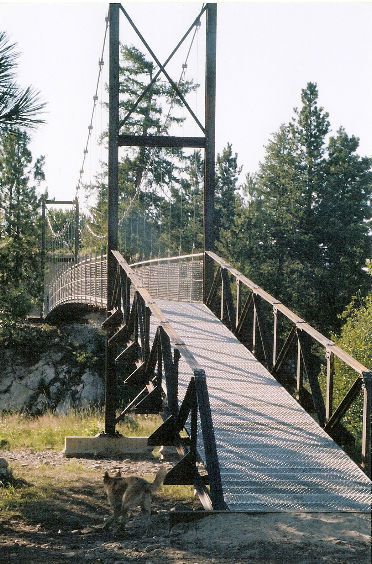|
Sahale's Bitterroot Suspension Bridge is
located on a private ranch near the confluence of the East and West Forks
of the Bitterroot River. The bridge spans the West Fork, affording access
to the sizable peninsula between the rivers. A Sahale cable bridge was
selected for the project by the Owner because of his strong interest in
erecting a light weight structure with little visual impact. In particular,
the Owner wished to be a conscientious steward of both the environment
and the history of his land.
The Bitterroot River and Valley is both magnificently beautiful and
steeped in the lore of the old West. The Salish people (aka Flathead)
occupied the valley from distant pre-history to the contact period where
there were numerous interactions with the Lewis and Clark Expedition and
subsequent explorers. The Corps of Discovery passed by the future bridge
site on Saturday, September 7th 1806, stopping briefly for lunch. Two
journal entries for the day describe the scene:
A Cloudy & rainie Day the greater Part of the Day dark & Drisley
we proceedd on down the river thro a Vallie passed Several Small Runs
on the right & 3 creeks on the left. The Vallie from 1 to 2 miles wide
the Snow top mountains to our left, open hilley Countrey on the right.
Saw 2 horses left by the Indians Those horses were as wild as Elk. One
of our hunters Came up this morning without his horse, in the course of
the night the horse broke loose & Cleared out- we did not make Camp untill
dark, for the want of a good place, one of our hunters did not join us
this evening. He haveing killed an elk packed his horses & could not overtake
us.
---Captain William Clark
We set out early in a cloudy cool morning; and our hunters went on
as usual. We proceeded down the creek, and in our way we were met by a
hunter, who had not come in last night, and who had lost his horse. We
halted at 12 o'clock, and one of the hunters killed 2 deer; which was
a subject of much joy and congratulation. Here we remained to dine, and
some rain fell. On the south of this place there are very high mountains
covered with snow and timber, and on the north prairie hills. After staying
here 2 hours we proceeded on down the creek; found the country much the
same as that which we had passed through in the forenoon; and having travelled
about 20 miles since the morning, encamped for the night. The valley is
become more extensive, and our creek has increased to a considerable river.
---Sergeant Patrick Gass
In the years following Lewis and Clark, the Bitterroot Valley became
a nexus of sorts for almost every pioneering explorer of renown in the
Rocky Mountain West during the fur trade/mountain man era. Between 1822
and 1829 alone the valley was visited by trappers Michel Bourdon, Finian
McDonald, and Alexander Ross leading dozens of men in various trapping
expeditions. Competition was keen over trapping, particularly between
expeditions launched by Canada's Hudson Bay Company and the rival American
Fur Company. Of the latter, Americans Jedediah Smith, William Sublette,
David Jackson, Thomas Eddie and Arthur Black all passed near the site
of Sahale's Bitterroot Bridge. Peter Skein Ogden, William Kittson and
56 men of the Snake River Brigade passed near the site too, as did Thomas
Fitzpatrick and a party of trappers including Kit Carson who entered the
valley from the Salmon River.
Later, in 1877, Chief Joseph and his valiant band of Nez Perce fleeing
General O.O. Howard brushed past the bridge site en-route to the Big Hole
Valley, Yellowstone, and their eventual surrender near the Canadian Border.
A scant two years later a pony express route was established past the
bridge site to carry mail between emergent Missoula and Bannack, the Territorial
Capitol.
Rivers are eternal, when viewed from a human vantage point. The Bitterroot,
like many rivers, is a manifestation of enduring natural beauty but also
a witness to grand human aspirations, suffering, and failings. Bitterroot
waters flowing today beneath Sahale's Bridge are little changed from those
that slaked the thirst of the Corps of Discovery over lunch one Saturday
in September of 1806, or did the same for a Salishan hunter one thousand
years earlier.
|
 |

